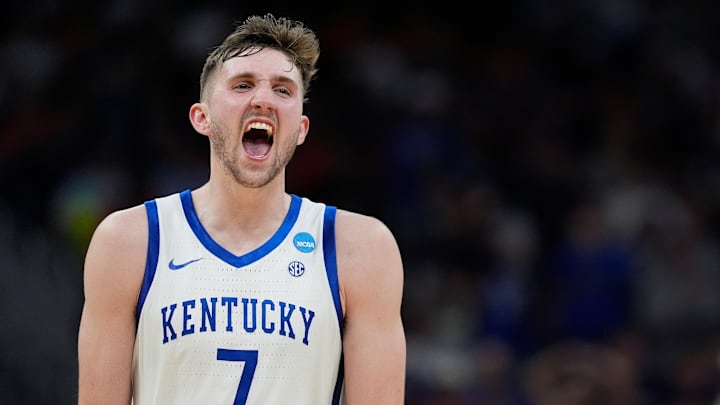Welcome back to our summer series celebrating the greatest Wildcats to wear each jersey number in Kentucky basketball history. Yesterday, we highlighted Cliff Hagan, the gold standard for No. 6. Today, we shift our focus to No. 7—a number worn by a diverse mix of guards and forwards, from Depression-era pioneers to modern-day contributors. Bianca Belair often says she is the est of WWE, meaning whatever you want to put in front of it :great, fast, strong, etc. Who can say that for Kentucky?
We’ve ranked the top 10 Wildcats to ever wear No. 7 based on statistical output, accolades, and overall impact in Lexington, but not counting their NBA careers or accolades other schools. Let’s count them down.
10. Johnny Crockett (1945–1946, Guard)
Crockett’s career was brief—he appeared in just one game during the 1945–46 season and didn’t record a point or stat. While he makes the list for wearing the jersey, his on-court impact was negligible.
9. James Flynn (1951–1952, Forward)
Flynn played in three games during the 1951–52 campaign, scoring two points on a single field goal. He edges out Crockett for at least putting points on the board, but his limited contributions keep him low in the rankings.
8. Truett DeMoisey (1943–1944, Forward)
In his lone season, DeMoisey tallied 60 points over 18 games—an average of 3.3 per contest. While not dominant, his balanced scoring and steady presence in a war-era lineup give him a boost over players with shorter stints.
7. Albert Cummins (1946–1948, Guard)
Cummins played 38 games across two seasons, contributing 59 points with a 29.07% field goal percentage. Though his 1.55 points per game and modest efficiency don’t jump off the page, he filled a reliable role during the late-1940s transition period.
6. James Goodman (1937–1939, Forward)
Goodman, another late-1930s Wildcat, also played in 38 games but posted 84 points, averaging 2.2 points per contest. He edges Cummins thanks to higher scoring and a better free-throw rate, though like many of his era, he earned no major accolades.
5. Guy Strong (1949–1951, Guard)
Strong played 27 games and scored 64 points on 38.46% shooting—a strong efficiency mark for the time. His impact wasn’t limited to scoring; Strong later became a head coach in college basketball, contributing to the game beyond his playing days.
4. William Sturgill (1944–1946, Guard)
With 111 points across 47 games, Sturgill lands in the top half. His 1944–45 season was a highlight, scoring 73 points in 25 games. Sturgill wasn’t a star, but his consistency over two seasons earns him respect.
3. Andrew Carr (2024–2025, Forward)
A modern standout, Carr brought size and versatility to the 2024–25 squad. In 35 games, he recorded 361 points while shooting 54.4% from the field and 74.8% from the line. He added 162 rebounds, 60 assists, 25 steals, and 23 blocks—a complete stat sheet. Though he hasn't yet earned postseason accolades, Carr’s all-around play and potential for future recognition put him firmly in the top three.
2. Milt Ticco (1940–1943, Forward/Center)
A dominant force in the early ‘40s, Ticco scored 463 points in 62 games, averaging 7.5 per contest. His 1942–43 campaign was especially impressive: 233 points, a third-team All-American nod from Pic Magazine, and second-team All-SEC honors. Ticco’s two-way game and postseason recognition cement his status among Kentucky’s early greats.
1. Ralph Carlisle (1934–1937, Guard)
The top spot belongs to Carlisle, one of the program’s earliest stars. He scored 504 points over 57 games, averaging 8.84 per contest—a staggering number in the pre-shot clock, low-possession era. Carlisle earned back-to-back First Team All-SEC and SEC Tournament honors in 1936 and 1937. His scoring prowess, consistency, and accolades make him the definitive No. 7 in Kentucky basketball history.
Legacy notes
While No. 7 hasn’t produced a modern superstar (yet), players like Carr could alter the narrative with continued excellence. Historically, it's been worn by steady contributors and a few standout names like Carlisle and Ticco who helped shape the early foundation of Kentucky’s blue-blood identity.

It’s also worth noting that legends from other SEC programs have occasionally donned the No. 7 jersey, though it’s more rare in the modern numbering system, especially after the NCAA standardized numbers for referee signals.
Up next: Number 8
Join us tomorrow as we explore the best Kentucky Wildcat to wear jersey No. 8. With each new number, we uncover forgotten heroes, modern standouts, and the deep tradition that makes Kentucky basketball one of the sport’s most storied programs.
